News
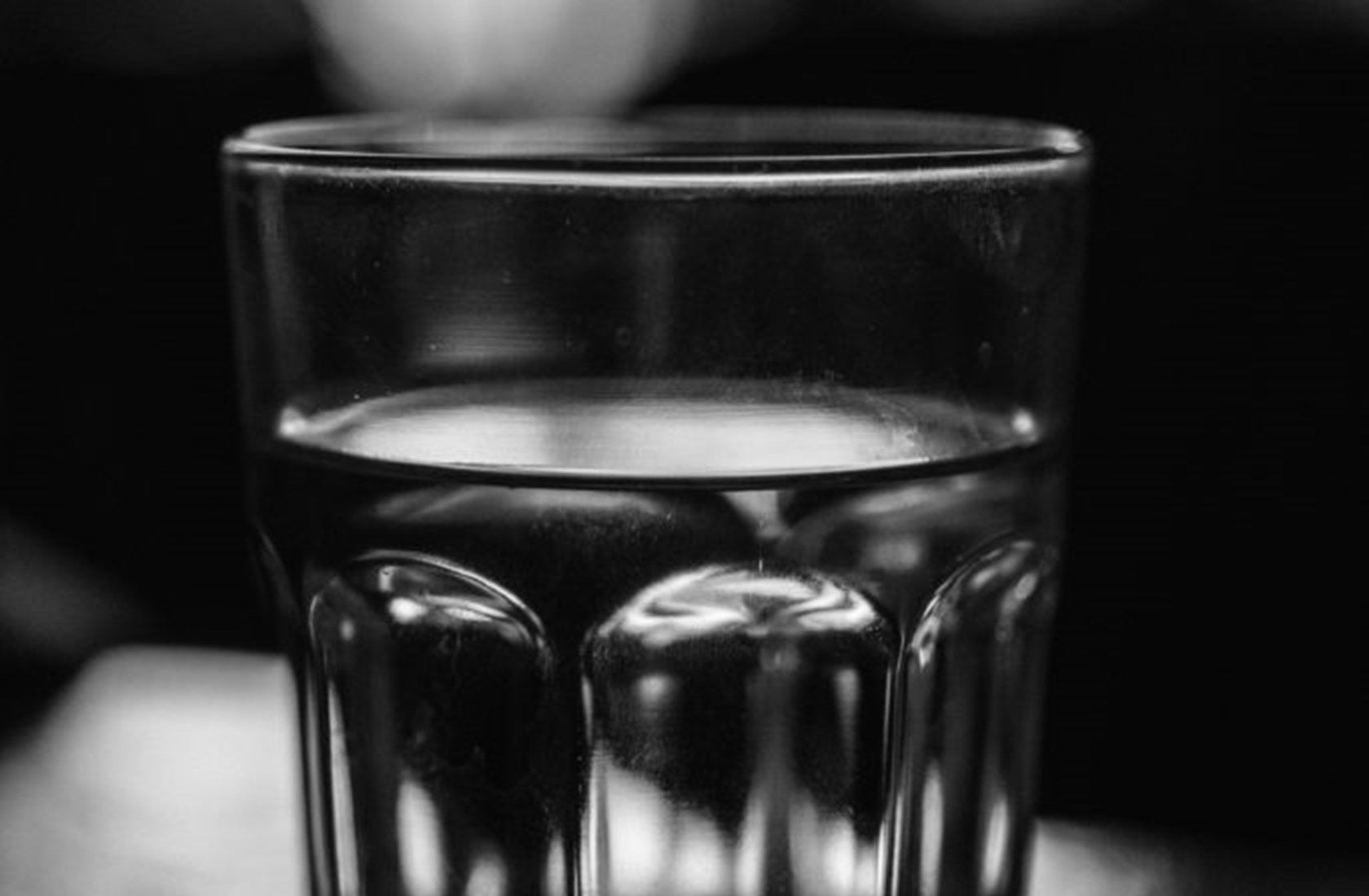
News
Drink 8 Glasses of Water a Day. Why?
on Sep 30 2025
Around 60% of a human body is water: blood 83%, muscle 75%, brain 75%, skin 72%, bone 22%, fat 10% water. We need water for every biological function. And then we excrete it.
So, we’re constantly having to replenish our bodies’ water content. Every day – many times a day – we must drink water. If we drink no water at all, we’ll be dead in three days.
Why eight glasses of water?
The European Food Safety Authority (EFSA) recommends a daily fluid intake of 2500ml for men and 2000ml for women.
Around 20% of our fluid intake comes from the food we eat. Therefore, when it comes to the amount we drink, 2000ml (for men) and 1600ml (for women) is adequate.
The eight glasses are based on the assumption that an average drinking glass holds between 200ml and 250ml; that’s 1600 to 2000ml.
“Eight ounces eight times a day” is a mantra often heard, especially in the US, where eight lots of eight fluid ounces equals 1892ml. In the UK, eight lots of eight fluid ounces equals 1818ml.
So, why eight glasses?
Is this just a catchy mnemonic?
Maybe not.
Metabolic water
Approximately 8-10% of a mammal’s water is obtained through the body’s aerobic metabolism, which is the oxidisation of carbohydrates.
This is a very small percentage compared to many other animals, including birds, who rely on a higher percentage of metabolic water. Birds excrete waste products from the blood in the form of uric acid, passed via the anus, as opposed to the highly diluted urine that mammals excrete by the urethra.
This contrast in the way mammals and birds maintain a healthy level of hydration brings home the fact that we rely heavily on water intake. Unlike migrating birds, who are for long periods hydrated exclusively by metabolic water, we must consume a high volume of water in order to function effectively.
Effects of dehydration on cognitive function
Dr Caroline Edmonds, Professor of Experimental Psychology, has led numerous studies surrounding the effects of hydration levels on cognition. One area of her research was a study of the expectations associated with good hydration – an investigation into the extent to which the benefits of hydration can be attributed to a person’s preconceptions. A study in which one group of subjects was made aware of the nature of the experiment, and the second group was told that the study was part of research into the effects of repeated cognition tests, showed that expectation made no impact at all.
In 2013, Dr Edmonds et al found that water ingestion enhanced cognitive functions such as reaction time, concentration, memory, happiness, and alertness. Even when subjects were already adequately hydrated, they showed improved cognition immediately after drinking water.
Because healthy kidneys are capable of excreting as much fluid as necessary – as much as 1 litre per hour – it’s unlikely that you could ever drink too much water. In those rare cases of fatal hyperhydration, death was caused by sodium deficiency due to over-dilution.
Drink eight glasses of water a day
All day, every day, your body is using water to process food, nourish trillions of cells, produce neurotransmitters and hormones, cushion joints, regulate temperature, and excrete waste.
We’re all familiar with the sensation of thirst and recognise it as a signal that we need to take in fluid. But when we feel thirsty, we’re already dehydrated.
Maybe there’s some sense in saying “drink eight glasses of water a day”. This advice gives us an idea not only of how much we should drink, but also of how often. We’re continually losing water, so we should be continually rehydrating.
So – drink a glass of pure, chilled water eight times a day, and you’ll be on the right track to good hydration.
And don’t worry too much about the size of the glass!

News
Pure water - H2O and Nothing Else
on Sep 30 2025
What is tap water?
UK tap water, harvested from reservoirs (surface water) and aquifers (groundwater), is of exceptionally high quality. To make it safe to use, the water is filtered and disinfected before entering the mains water supply. After the filtration process, chlorine is added to the water.
Acting as an oxidising agent to microorganisms, whose surfaces are typically negatively charged, chlorine effectively breaks pathogens apart, either killing them or rendering them inactive and unable to multiply.
What is purified water?
Purified water is H2O. Nothing else. Just molecules made up of three atoms: two hydrogen and one oxygen.
Pure water has no taste or smell, and it doesn’t conduct electricity.
Can you purify tap water by boiling it?
When water is boiled, almost all pathogens – i.e. potentially harmful living organisms – are killed.
Bacteria that might find their way into the water supply include:
Escherichia coli, which can cause urinary tract infection (UTI), cholecystitis (inflammation of the gallbladder), and pneumonia.
Vibrio cholerae, which can cause cholera.
Legionella pneumophilia, which can cause Legionnaire’s disease.
Potentially harmful viruses are sometimes found in mains water supplies. They include:
Rotavirus A, B, and C, a cause of gastroenteritis.
Enterovirus B, a cause of gastroenteritis, respiratory disease, and meningitis.
Norwalk virus, the cause of winter vomiting bug.
Waterborne fungal pathogens include:
Candida albicans, the cause of candidiasis.
Candida parapsilosis, which can cause sepsis.
Acremonium strictum, a cause of mycetoma.
These are a few examples of the microorganisms that are sometimes found in our water supply.
Very few living things can survive at temperatures of 100°C and above. Therefore, boiling tap water will almost certainly kill any pathogen. Boiled water is sterilised water.
But boiling doesn’t purify tap water.
Can boiling tap water remove metals and minerals?
Although boiled mains water is sterile, it will still contain traces of inorganic material – for example:
Minerals, metals, and microplastics that originate from the source.
Metals and plastics from the supply’s physical infrastructure.
Chlorine and other sterilising additives.
Boiling water will not remove metals and minerals. In fact, because some of the water evaporates in the boiling process, the remaining water will contain a slightly higher concentration of inorganic material. Traces of calcium, manganese, magnesium, sulphur, copper, iron, potassium, chlorine, etc. won’t do you any immediate harm, but over a long period of time, the accumulation of these materials can affect your immune system.
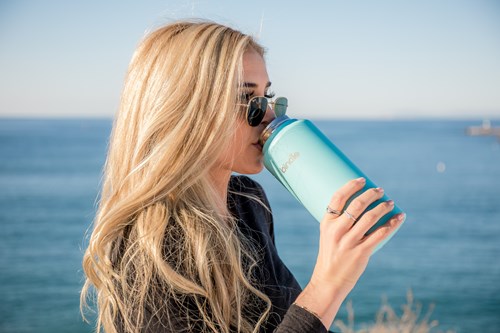
News
Flavour Trends in Soft Drinks for Adults
on Sep 30 2025
Once upon a time, flavoured soft drinks were for children. In a social setting, adults who chose not to drink alcohol were faced with the undignified choice of fruit squash or lemonade.
Fortunately, things are changing.
Teetotal Brits
A quarter of a century ago, approximately 10% of adults in the UK classified themselves as “non-drinking”. In 2022, this figure has doubled, with 20% of British adults choosing not to drink alcohol. The shift to abstention is particularly noticeable in young adults.
One explanation put forward by sociologists is the peer support and validation provided by social media. A generation ago, young people’s social lives were heavily reliant on alcohol. Insecurities and self-doubt could be cushioned by alcohol, and the act of drinking together established a sense of belonging. For many young people today, that vital sense of belonging is found through social media.
Another influence on this non-drinking trend is an acute awareness of health and wellbeing. The sight of a young adult going about daily life with a bottle of water in hand (or maybe peeping out of a rucksack) has become a familiar one. And when a round of hot drinks are being made, it’s not unusual, nowadays, to hear somebody ask for a glass of cold water.
Flavoured soft drinks for grown-ups
This welcome decrease in alcohol consumption among the younger generation of adults goes hand-in-hand with an explosion of innovation within the soft drinks market. New and exciting flavours are bursting onto the soft drinks scene, along with a wide range of low-calorie, sugar-free drinks that are quite at home beside the beers and wines at any summer barbecue or house party.
A recent study set out to discover what people of between 18 and 34 years look for in a bottled soft drink. The study revealed:
People in this age group wanted a healthy option without sacrificing flavour.
The (average) top priorities in selecting a healthy soft drink were: (a) it contained raw fruits or vegetables, (b) it was low in sugars and calories, (c) it was organic.
Participants most commonly consumed bottled drinks while at work. The next most common times were: during workouts and relaxing at home.
People were attracted to simplicity of flavour profiles and packaging.
Bold flavours and colours were taking over from delicate, understated flavours and colours.
Citrus flavours
Citrus flavours have always been a cornerstone in the soft drinks market, but recent trends are branching out, away from the traditional lemon (Citrus limon) and sweet orange (Citrus x sinensis*) – a natural hybrid of the pomelo (Citrus maxima) and the mandarin (Citrus reticulata).
Flavours that are becoming more and more popular in adult soft drinks include grapefruit, blood orange, and yuzu.
The pomelo and sweet orange were introduced to the West Indies, from Asia, in the 17th century. A cross between the two fruits occurred in Barbados, resulting in the hybrid we know as grapefruit (Citrus x paradisi*). Per 100 grams, raw grapefruit provides 40% of the reference intake for ascorbic acid (vitamin C).
Blood orange is a variety of sweet orange, with its own unique flavour. The main attraction of blood orange is its natural deep-red colour.
Yuzu (Citrus junos) is a yellow, aromatic fruit that can grow to the size of a grapefruit. Its taste is a crisp and fresh combination of lemon and grapefruit – not for those who aren’t so keen of sour flavours!
* The x in a name identifies the species as originating from a hybrid.
Tropical flavours
The “tropics” refers to the area of the Earth between two latitudinal lines known as the tropics of Cancer and Capricorn. Comprising approximately 25% of the Earth’s surface, the tropics form a wide belt around the equator.
Tropical areas are typically hot and fertile, and many different kinds of fruit are grown here for exportation all over the world.
Pineapple (Ananas comosus), which is indigenous to South America, was first introduced to Britain in the 1600s. For a couple of centuries, the fruit was a status symbol, so expensive that only the very rich could afford one. Rather than being eaten, the pineapple was displayed on the dinner table in stately homes, and was even hired out to those who could not afford one of their own!
These days, the pineapple is enjoyed for its flavour and health benefits, but there’ll always be a sense of the exotic in this spectacular fruit. Per 100 grams, raw pineapple provides 44% of the reference intake for manganese and 58% for vitamin C.
The mango (Mangifera indica) originates from south Asia and is the national fruit of India, Pakistan, and the Philippines. Globally, approximately 43 million tonnes of mangoes are produced each year, and with its sweet flavour and soft yellow flesh, mango is the UK’s 15th-most popular fruit, liked by 67% of the population. Per 100g, raw mango provides 60% of the reference intake for vitamin C.
Nostalgia and national identity
The world is becoming smaller, and if a food is grown anywhere on Earth, there’s a good chance it will be available to us in the UK. We take for granted a wide selection of citrus fruits, which evolved in Asia, and we’re accustomed to exotic fruits that are grown in the tropics. But despite a desire to embrace diversity in our diets, there still exists a need for reassuring, nostalgic taste profiles. For instance, a fresh interest in British apple varieties is creeping into our flavour choices.
Originally a type of mead – i.e. a fermented drink – dandelion and burdock is a drink that’s been around in Britain since the middle ages. Nowadays the drink is usually carbonated. With its roots set firmly in British history, this traditional beverage provides an affirmation of national identity.
Dandelion (Taraxacum officinale) and burdock (Arctium lappa) are both indigenous to Europe and Asia, but dandelion, a rich source of nutrients, is now naturalised all over the world.
Rhubarb, the fleshy stalk of species from the genus Rheum, is native to Siberia and has been grown in Britain only since the end of the 18th century. However, during WWII, when the price of Yorkshire-grown rhubarb was capped at one shilling per pound, to keep it affordable to everyone, it became a national favourite. Rhubarb contains, per 100 grams, 28% of the reference intake for vitamin K.
Health and flavour
As we become more health conscious and concerned about how we care for our bodies, the soft-drinks market is coming up trumps with a plethora of natural and delicious alternatives to those traditional sugary treats of the past.
Rather than narrowing our options, the trend for a healthy diet is opening up a whole new world of flavours.

News
Why Every Office Needs a Boiling, Chilled, and Sparkling Water Tap
on Sep 30 2025
There are so many reasons! These taps are cost-effective, eco-friendly, safe, convenient, fun, and stylish.
A boiling- and chilled-water dispenser unit puts an end to queues at coffee break, excessive steam, limescale in your drinks, and the risk of dangerous spills.
With sparkling water on tap, staff can liven up fruit juice with a bit of fizz, or just enjoy the fresh, tingling sensation of chilled carbonated water.
The many reasons why every office needs a boiling-, chilled-, and sparkling-water tap can be summed up, really, in three big reasons:
Stop using plastic bottles. Keep staff hydrated. Show off your brand’s professionalism.
1. Join the fight against plastic pollution
In the UK, around seven-and-a-half billion plastic bottles of water are purchased every year. Once the brand-new plastic bottles are made, they have to be filled, and whether they’re taken to the water or vice versa, there’s transportation involved. Next step: the packaged water is transported to thousands of commercial outlets. Over the course of each year, seven-and-a-half billion bottles of water are purchased in the UK; the water is consumed; the bottle is (in 55% of cases) disposed of and collected by a refuse collection vehicle that chomps through a gallon of fuel every four miles.
Much of this discarded plastic ends up in landfill – and a lot of it finds its way into the sea. Plastic has only been around for 150 years, and already this non-biodegradable material is clogging up the oceans and filling up the land. Plastic pollution is affecting thousands of animal species as it spreads through the food chains.
Celluloid, the world’s first artificial polymer, was invented in 1869. The killing of elephants for their ivory was getting out of hand, and this new material, celluloid, was welcomed as an eco-friendly alternative. Now the plastic itself is an ecological hazard.
How do we slow down this assault on the natural environment?
By not buying bottled water.
And this is one reason why every office needs a boiling-, chilled-, and sparkling-water tap.
2. Keep hydrated
Headaches, palpitations, memory loss, lack of concentration, depression, insomnia, urine infection, constipation, disorientation, tiredness, kidney failure, dry mouth, bad breath, sore joints, irritability, confusion, dizziness …
All symptoms of dehydration.
More than half of the human body is made up of water. Without water, we die. Without enough water, we can’t function at full capacity.
Every single one of a body’s trillions of cells depends on water for survival.
Blood (78% water) carries nutrients to each cell, and works most effectively when well diluted. A high volume of low-concentration blood will flow freely, saving strain on the heart and enabling the production of neurotransmitters for effective cognition.
Our built-in shock absorbers, cerebrospinal fluid (which protects the brain) and synovial fluid (which cushions and lubricates our joints), are made up mostly of water. One of the effects of chronic dehydration is accelerated deterioration of the joints. Physical discomfort as a result of sore, aching joints – or other conditions associated with dehydration, such as constipation, kidney stones, and headaches – can have a detrimental effect on productivity.
Water, however, can’t be stored up in our bodies. It’s always just passing through. So, water intake needs to be frequent and plentiful.
This is another reason why every office needs a boiling-, chilled-, and sparkling-water tap.
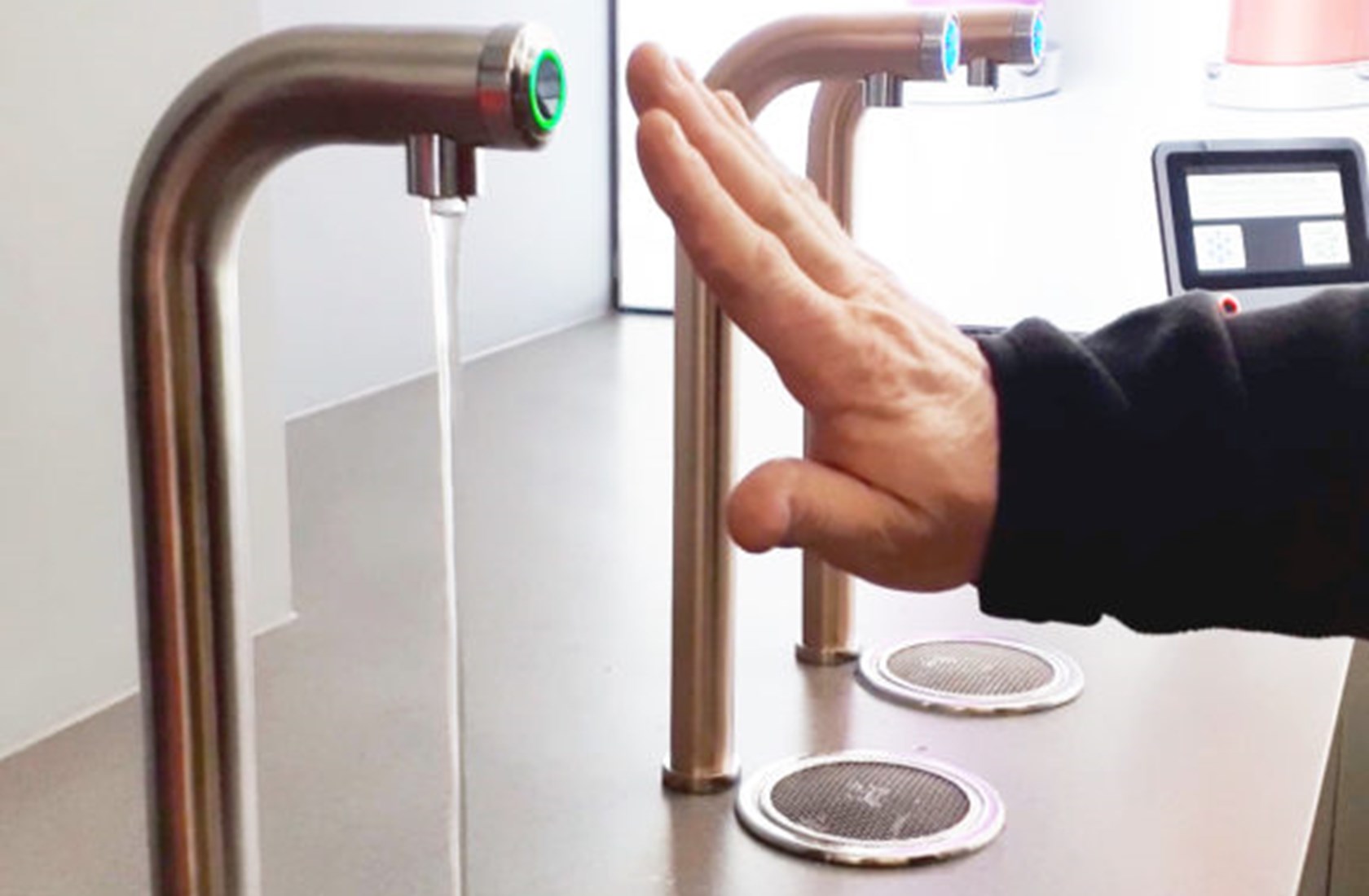
News
Touchless Technology: 2021 Outlook
on Sep 29 2025
Touchless technology is becoming more and more a part of everyday life. It’s used in computer games, communication and media technology, assistance technology, and security. In response to the COVID-19 pandemic, touchless technology has been employed more than ever in the field of hygiene, in a battle against the spread of microorganisms.
Touchless sensing
Before 2020, motion sensors had already become a familiar feature of public places. Toilet flushes, soap dispensers, water dispensers, hand driers, air conditioners, lights … All can be operated by means of a signal triggered by an interruption or reflection of an infrared beam.
Automatic doors are also a well-established appliance of touchless technology. Whereas convenience is traditionally the motive for automatic doors, these marvellous pieces of machinery are coming into their own as a health benefit. This year, walking through an automatic door has taken on a new significance; it’s one more shared surface that we don’t have to touch.
Gesture recognition
Gesture recognition goes that step further. Whereas sensor technology reacts in a basic on/off fashion (to sense or not to sense), gesture recognition technology works on computer algorithms that match 3D images of real-time gestures to items stored in a gesture library. When a perfect match is found for a specific gesture, the corelating command is executed.
Gesture recognition technology first made an appearance in the 1970s, and since then, it’s come on in leaps and bounds, driven by the gaming industry.
Just like with touchless sensing, gesture recognition is taking on a new role. Viral contamination via skin – particularly hands – is a concern that’s recently become a priority concern, and touchless technology has an important part to play in providing alternative means of operating devices in shared spaces.
Take, for instance, Aqua Libra Co’s Aqua Touchless. This piece of technology works in tandem with two of the highest-performing taps on the market today (the Aqua illi three-in-one tap and the modular Aqua Alto tap) and an industry-leading bottling system (the Aqua Bottler), which is capable of dispensing up to 180 litres of pure water every hour. With Aqua Touchless, the outlets are controlled via touchless gestures, allowing staff, customers, and visitors to take full advantage of the water-dispenser system without making physical contact with shared surfaces.
Fingerprinting
Fingerprinting as a means of signature has been used in various parts of the world for hundreds of years. As a means of forensic identification, it first came into use in the UK in the 1890s. The first person to be convicted on the strength of fingerprint evidence was 41-year-old Harry Jackson, who, on being found guilty of stealing billiard balls, was imprisoned in 1902.
Today, more than 100 years on, fingerprint recognition can be a touchless process. This secure and convenient method of authorisation will no doubt be opening many doors – both physical and metaphorical – in the very near future.
Voice recognition
Voice recognition made its debut appearance in 1952 in the form of “Audrey” by the American telecommunications company, Bell Telephone Laboratories Inc. Ten years later, Audrey was outshone by IBM’s Shoebox system, which had the ability to recognise 16 words.
The four major voice-recognition programmes – Alexa (Amazon), Voice Search (Google), Siri (Apple), and Cortana (Microsoft) – have opened up worlds of opportunities for the elderly, physically disabled, and visually impaired.
Among their many functions, these devices allow the user to convert spoken language into printed text, carry out Internet searches, set reminders and alarms, and order take-away meals.
Personal devices
Mobile phones are rapidly becoming indispensable tools.
Via our mobile devices, we can create connections, checks, and records. By scanning QR (quick response) codes, RFID (radio frequency identification) tags, and electronic chips, we can track products, invoices, payments, and documentation. All with minimum touch and a reduced risk of transmitting COVID-19.
Technology rises to the challenge
The COVID-19 pandemic has accelerated certain trends that might otherwise have taken a few more years to reach the point we’re at now. The concept of hygiene has taken on a new dimension, and technology has risen to the challenge of meeting new needs.
Aqua Libra Co's water-dispenser systems have always delivered 100% purified water, free from waterborne bacteria and viruses. Now you can enjoy extra protection with Aqua Touchless.
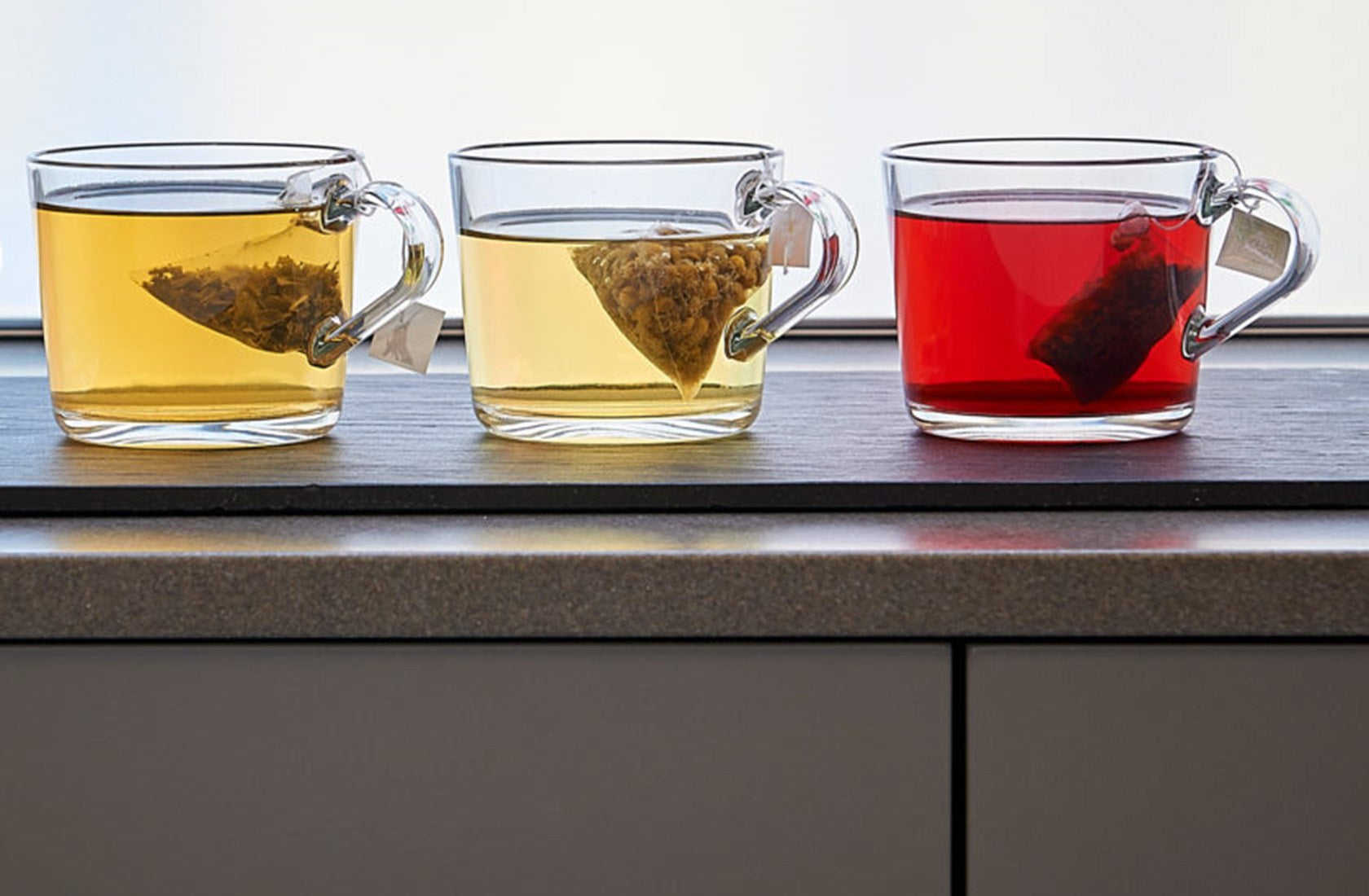
News
on Sep 29 2025
We all know what’s meant by herbal tea, even if many of these drinks contain neither herb nor tea.
Tea is an infusion of cured Camellia sinensis leaves. Herbs are aromatic plants with leaves, seeds, or flowers that are used in medicine and for flavouring food.
However, as language tends to bend and adapt to common usage, herbal tea is the most common term for a tisane, which, strictly speaking, is an infusion of caffeine-free plant material.
Herbal teas are made from the flowers, seeds, fruits, roots, and leaves of hundreds of different plant species. For thousands of years, plants have been used for their medicinal properties, and one of the most common ways of ingesting their goodness is in the form of an infusion. Besides the health benefits of the plants themselves, drinking herbal tea is a tasty way to stay hydrated.
Ask 100 people to pick their top 5 herbal teas, and you’ll probably get 100 different combinations. The following “Top 5 Herbal Teas” is just our take on the subject.
How close is this list to your own?
1. Magnolia tea for relaxation
There are numerous herbal teas taken for their sedative properties.
Lavender, lemon balm, and passionflower teas, for example, are all popular infusions for the easing of stress and anxiety. They’re commonly drunk in the evening, as a way to wind down before bedtime.
Valerian root tea has been used for centuries as a remedy for insomnia and is arguably one of the most effective; the thing is, it smells and tastes revolting!
Gamma-aminobutyric acid (GABA) is an inhibitory neurotransmitter that reduces neuronal excitability throughout the nervous system. It’s a chemical that’s widely used in antianxiety medication. GABA receptors are proteins that respond to GABA and effect a biological response.
Honokiol and magnolol (both with the chemical formula C18H18O2) are compounds found only in plants in the genus Magnolia – honokiol in the leaves and seeds; magnolol in the bark.
Honokiol and magnolol enhance activity in GABA receptors, helping to ease anxiety and relieve insomnia.
Another function of GABA is to inhibit the production of the hormone glucagon. Glucagon, which is produced in the pancreas, raises the concentration of glucose in the bloodstream, counteracting the effects of insulin. When GABA receptors are kept healthy by compounds such as honokiol and magnolol, neural excitability and the production of glucagon are subdued – thus enhancing the efficacy of insulin.
With a pleasant zingy taste and the calming effects of honokiol and magnolol, magnolia tea gets our vote for Best Tranquilising Tea.
2. Cinnamon tea for circulation
There are approximately 250 species in the genus Cinnamomum, and for centuries the bark of many of these trees – particularly Cinnamomum zeylanicum and Cinnamomum cassia – has been used for flavouring food and for medicinal uses.
Cinnamon is actually a bit of an all-rounder, as it’s been found to have anti-inflammatory, antiviral, antibacterial, and coagulant properties – as well as a propensity to promote the growth of beneficial bacteria in the gut whilst suppressing the growth of pathogenic bacteria.
However, cinnamon tea is outstanding in one particular area. It can contribute to a reduction in blood pressure by improving the dilation of blood vessels, which is conducive to better blood flow. Therefore, cinnamon tea is our choice for Best Healthy Heart Tea.
3. Ginseng for the immune system
Ginseng is named after Panax ginseng, the species originally used for its medicinal properties. Ginseng refers to the root of plants in the genus Panax. Panax is from Greek, meaning ‘all healing’.
Ginseng tea is one of those marvellous all-rounders. It’s great for the heart and circulation, for cognitive function, and for intestinal health. If you’re looking for a herbal tea to promote general health and wellbeing, ginseng should certainly be considered.
Yes, ginseng is a bit of a jack-of-all-trades, but it does have its own specialisation. Ginseng takes a lot of beating when it comes to enhancing resistance to illness. With beneficial effects on both the innate defences and the adaptive responses of the immune system, ginseng tea can take on any other herbal tea for the title of Best Tea for Immunity.
4. Peppermint tea for digestion
Liquorice (Glycyrrhiza glabra) root tea is brilliant for preventing and treating stomach ulcers. The sweet taste of liquorice comes from glycyrrhizin, a compound unique to G glabra, which is actually sweeter than sugar.
Senna tea, an infusion made from the leaves of the senna plant (Senna alexandrina), stimulates intestinal contractions and bowel movements – a gentle cure for mild constipation.
Peppermint tea is an infusion made with leaves of the peppermint plant – the sterile hybrid of spearmint (Mentha spicata) and water mint (Mentha aquatica). Because it produces no seed, peppermint reproduces vegetatively – i.e. asexually.
The anti-inflammatory properties of peppermint help to relax and soothe muscles in the intestines and stomach, relieving the symptoms of irritable bowel syndrome (IBS). And it’s been shown to reduce bloating, dyspepsia, acid reflux, and cramping. Peppermint tea is the perfect after-dinner drink.
First prize for Digestive Aid goes to peppermint tea.
5. Ginger tea: best all-rounder
Ginger (Zingiber officinale) regulates blood sugar level; reduces high blood pressure; improves blood circulation; eases digestion; relieves nausea; boosts the immune system; and it’s anti-inflammatory.
Probably the best-known herbal remedy for nausea, ginger tea is drunk by pregnant women who are experiencing morning sickness. Many people who suffer from travel sickness will drink a cup of ginger tea before setting out on a journey – or even take along a flask of hot ginger tea.
Ginger tea tastes lovely, just by itself. For some, though, it can taste a little bitter without a sweetener, such as honey or sugar. Ginger also goes very well with lemon, and there are numerous brands of herbal tea that produce a ginger-and-lemon blend.
Congratulations to ginger tea – Best All-Rounder.
Herbal tea in the office
Winter’s on the way. To keep hydrated at work, why not infuse your favourite herbal tea in pure, hot water. The many benefits of caffeine-free tisanes, combined with the ultimate goodness of water, will keep your mind and body well.
Creativity – here we come!
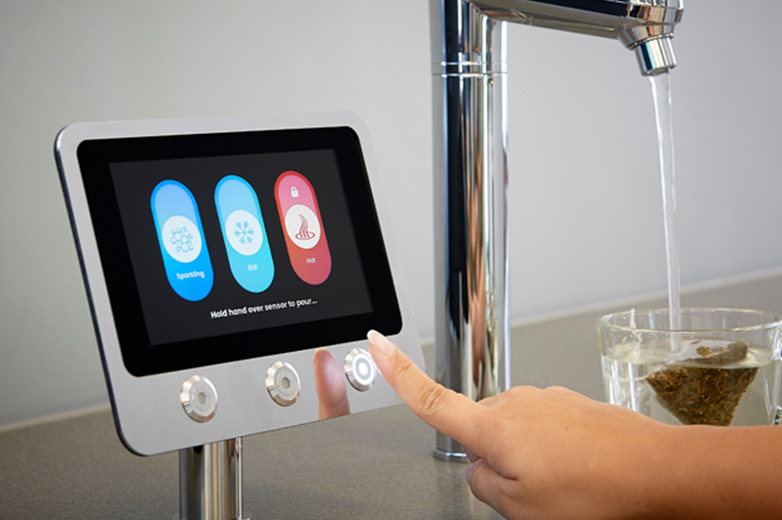
News
on Sep 29 2025
Over the past 18 months, as the world’s population has struggled with the diverse effects of COVID-19, there’s been a drastic change in society’s attitudes to shared surfaces.
Results of a Foolproof survey, published in April 2020, and a survey carried out by Piplsay one year later, in April 2021, provide a picture of these changing attitudes and an insight into people’s expectations.
Touch technology
Touch technology has become part of everyday life. It crops up everywhere – in vending machines, delivery signatures, ATMs, food and retail ordering, lifts, railway ticket machines, train doors, supermarket checkouts, and many other applications.
Highly valued for qualities such as security and efficiency, touch technology has quite suddenly lost some of its shine. A new version to physical contact between people – both directly and indirectly – has rendered this relatively new technology less appealing. As COVID-19 reached pandemic proportions, the world began to shy away from “dirty technology”.
Protection against COVID-19
The aim of Foolproof’s survey was to understand how UK citizens expected their behaviour to change when life returned to normal after the national lockdown. Results revealed that 25% of respondents believed they’d use cash machines less often and 48% planned always to use contactless payment where the limit allowed. Just over half of all participants in the survey said that they’d wash or sanitise their hands immediately after using a public touchscreen.
Touchless technology
A reluctance among consumers to use shared touch technology has led to increasing demand for touchless technology. Carried forward on a wave of necessity, the touchless- technology industry has sailed swiftly into a new era.
Certain forms of touchless technology are well-established elements of public spaces.
Motion-sensor technology, triggered by an interruption or reflection of an infrared beam, has long been employed to open doors, flush toilets, turn on taps, lights, and hand driers, and activate air conditioning systems.
For some time, voice-recognition programmes have been employed in the healthcare sector for record-keeping and Internet access. Voice technology has come a long way since “Audrey”, the world’s first voice-recognition programme created by Bell Telephone Laboratories Inc. in 1952.
Whereas sensor technology operates in an “on-or-off” fashion, gesture control works through computer algorithms that match up three-dimensional images of real-time gestures to digital items stored in a gesture library.
Protection against future viruses
Around 80% of people now consider public touchscreens to be unhygienic.
During the pandemic, there has developed an acute awareness of the ways in which viruses and other pathogens can be transmitted from person to person. With the potential for future epidemics and pandemics highlighted by the virulent spread of COVID-19, the additional hygiene measures we’ve adopted in the past 18 months have taken on a meaningful role beyond the parameters of this pandemic.
Of the 6,090 UK citizens who took part in the Piplsay poll in April 2021, 76% were comfortable with the increasing human-technology interaction, and 71% expected businesses to have touchless technology in place, post COVID-19. Approximately 44% say that their preference for touchless technology has increased during the pandemic, and 79% are more likely to choose touchless gesture control than a touchscreen.
Contact us
The gesture-controlled, smart-reporting Aqua Touchless can help you and your staff monitor your sustainability programme. To talk to us about how this safe, easy-to-use dispense solution can help keep your staff and customers COVID-safe, call 0800 080 6696 or email [email protected]. For a quote, please complete the online quote form.
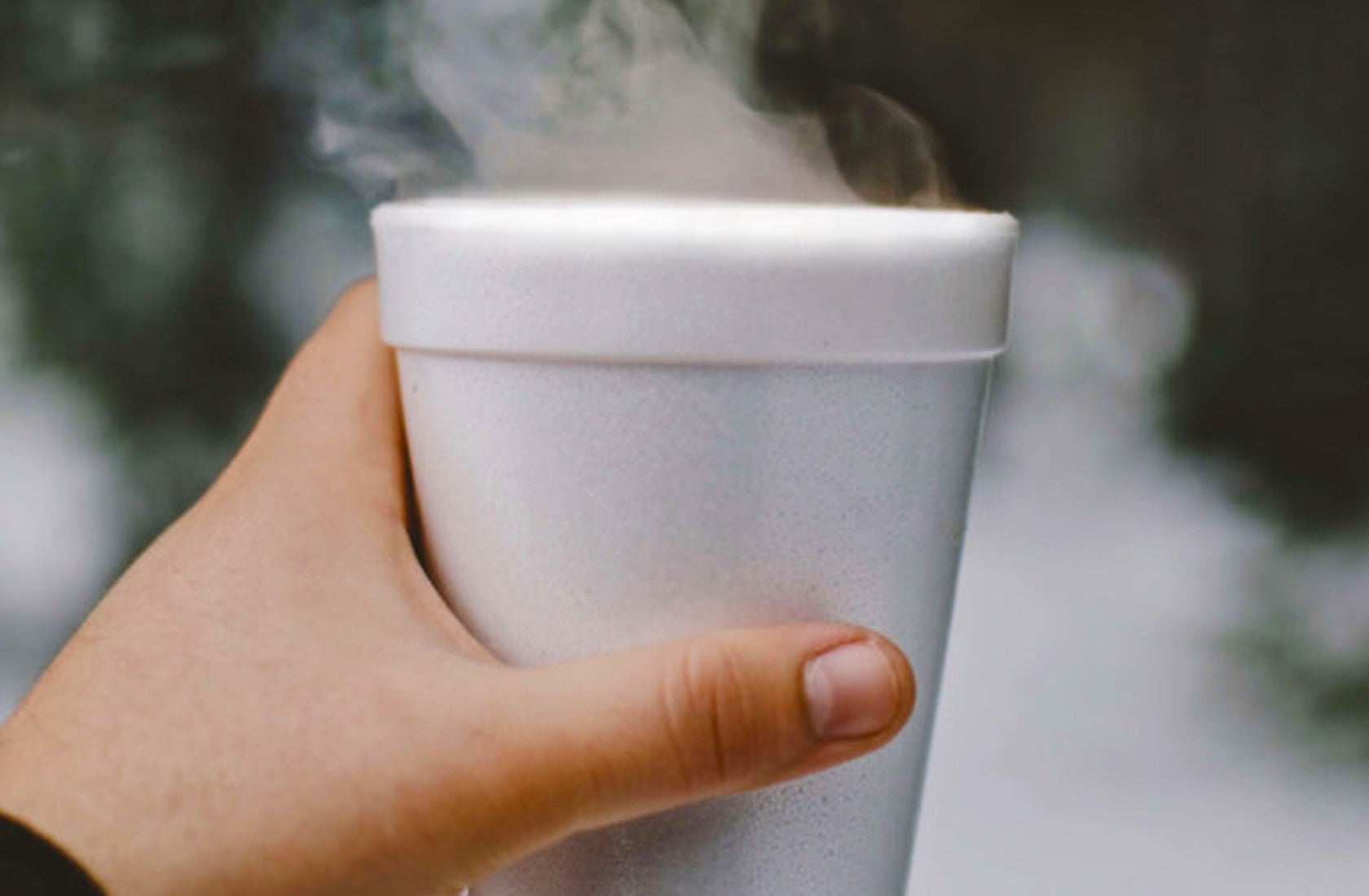
News
on Sep 29 2025
Around 3% of the Earth’s atmosphere is water vapour – a molecular gas comprising one oxygen atom bonded to two hydrogen atoms at an angle of 104.5°. Water vapour accounts for approximately 0.001% of the total amount of water on Earth.
Water is an amazing material. It makes up at least half of every living organism; it’s a very good solvent (nicknamed “the universal solvent”); and for many species, it’s the medium from which they absorb life-giving oxygen.
Solid water
One of water’s unusual features is that, as it freezes, its density decreases, effecting an increase in volume. In the case of most substances, density increases and volume decreases in the solid phase. So, why is water different?
As liquid water becomes cooler, it contains less thermal energy, so its molecules are less active. At around 4°C, water reaches a point where the molecules aren’t moving around enough to be pulled away from bonding in the way they prefer: hydrogen atom to oxygen atom. The result is that each hydrogen atom is between the oxygen atom in its own molecule and an oxygen atom of another molecule, creating an open, crystalline structure.
Due to the spaces in the molecular structure created by this particular bonding pattern, solid water has a lower density than liquid water.
Liquid water
It’s not until water warms up to that magic 4°C that the intermolecular bonds between hydrogen and oxygen atoms can be broken. Thermal energy makes the liquid water more dynamic, and the H2O molecules start to move around, repeatedly forming and breaking bonds. In the case of most materials, this would mean decreased density and increased volume; for water, it’s the opposite.
The problem with ‘steam’
‘Steam’ usually refers to ‘aerosol’ (abbreviation of aero + solution), otherwise known as ‘wet steam’. Aerosol describes liquid water droplets suspended within a gas – in most cases, air. Mist and cloud are examples of aerosols, and so is the hot mist that hangs over a pan of boiling water or the spout of a kettle.
Most of us would probably agree that we can see steam; that ‘steam’ is the same as ‘aerosol’.
The trouble is, the word ‘steam’ has wriggled its way into another definition. ‘Steam’ is often used to describe the gas phase of water, and this is where meaning and understanding start to break down. Most of us have a basic understanding of the science behind phase changes of water; but problems arise in communication.
The culprit is ‘steam’.
Maybe we should refrain from telling children that when water boils, it becomes steam. Yes, the liquid water does, eventually, become steam (aerosol). But only after it has turned into a gas at a temperature of 100°C and one atmosphere of pressure.
Rolling these two concepts into one word is misleading. (A bit like the word ‘love’, which is one word for many different concepts.)
Water vapour
The gaseous phase of H2O is water vapour.
Molecules from the surface of liquid water evaporate into the atmosphere as they absorb thermal energy and gain dynamism.
Liquid water also changes to water vapour through boiling – when it reaches 100°C at one atmosphere (atm) of pressure (one atm is Earth’s approximate atmospheric pressure at sea-level) or a few degrees lower at a lower pressure.
When water vapour cools and condenses into aerosol, the thermal energy is released.
The Earth’s temperature control system is all about water. Very much like our own!
Deposition and Sublimation
Usually, a phase transition takes place from solid to liquid and vice versa, and from liquid to gas and vice versa. Sometimes, however, a transition is made from gas to solid or from solid to gas, without passing through the liquid phase. Gas to solid is ‘deposition’, and solid to gas is ‘sublimation’.
Frost, that thin, dainty layer of ice on the ground, is formed when water vapour comes into contact with a solid that’s at a sub-zero temperature. A phase transition occurs as the water vapour turns to ice – a transition from gas to solid, without going through the liquid phase. This is an example of deposition.
Instant coffee: gotta love it! Thin layers of frozen coffee liquor are heated at a very low pressure, and the solid water becomes vapour without passing through the liquid phase. Freeze-dried coffee is an example of sublimation.
Hydration
Good hydration is conducive to health and wellbeing.
Good hydration is scientifically linked to high levels of productivity.
Good hydration is recognised in many corporations as an important factor in the building of dynamic teams.
Contact Aqua Libra Co to find out more about workplace hydration systems.
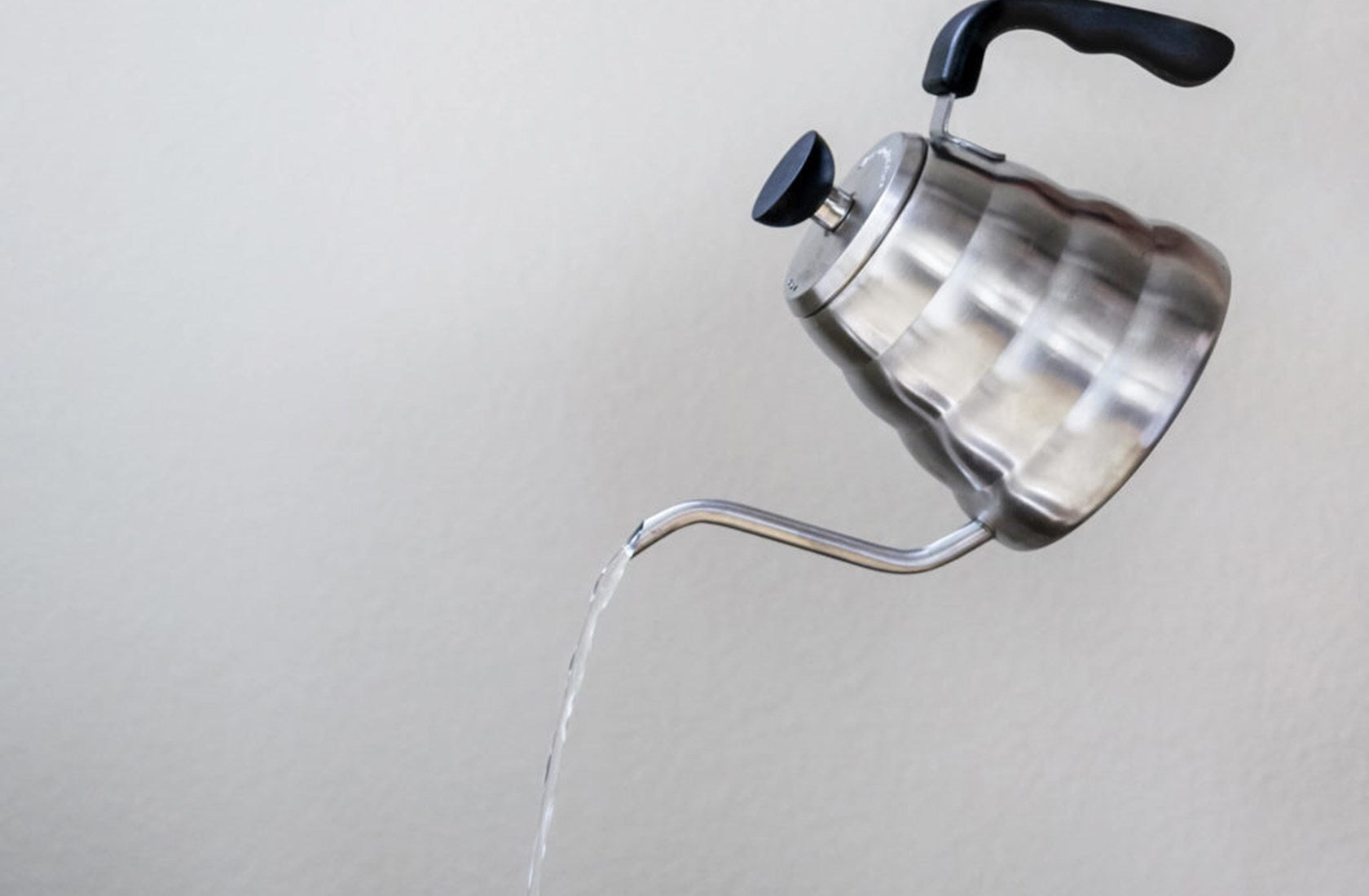
News
The Kettle: Past, Present, and Future
on Sep 29 2025
The kettle has been around for thousands of years. Made from thermo-conductive materials and fitted with a handle for suspension and/or carrying, the kettle (or cauldron) is a vessel for heating food and water.
Until the teakettle came into common use during the 18th century, ‘kettle’ was an all-encompassing term, making no distinction between the spouted pot with a lid and the open-top bowl.
Certain English terms reflect the traditional idea of a kettle: a ‘fish kettle’ is a long, shallow pot for cooking whole fish in; a ‘kettle drum’ is a large, bowl-shaped drum; a ‘kettle hole’ (a geological term) is a hollow, typically filled with water.
The kettle can be thanked for providing countless generations with boiled – and thus sterilised – drinking water. In China, people began to add green tea leaves to the hot water for some flavour – a practice that was first documented during the Shang Dynasty (approximately 1600 to 1100 BC). Vegetation of all kinds has been thrown into boiling water, including barley and other grains, which led to what we now call malt beer.
But let’s put aside, for now, the marvellous concoctions that have been created in this most ancient of appliances, and have a look at the kettle itself. Where does it come from? And where is it going?
What’s in a name?
By the middle of the 5th century AD, Britain was no longer a part of the Roman Empire. The people of Britain were speaking a mixture of Latin and Insular Celtic. It wasn’t long, however, before Anglo-Saxon migrants flooded into Britain, bringing with them Germanic languages that formed the basis of Old English.
The Oxford Dictionary of English cites the origin of ‘kettle’: “Old English cetel, cietel, of Germanic origin, from Latin catillus, diminutive of catinus ‘deep container for cooking or serving food’.”
Through repeated invasions of Britain by Norsemen from Scandinavia, the English language was strongly influenced by Old Norse. In Middle English, a ‘kettle’ or ‘cauldron’ was ketill.
Tool for life
Mesopotamia, in Western Asia, was the world’s main arena in terms of revolutionary human activity. The Neolithic (‘new stone’) Age saw the beginnings of settlements, agriculture, pottery, irrigation, and mathematics. With the Bronze Age came the wheel. And the kettle.
Bronze, an alloy of copper and tin, was the first deliberately created metal alloy. In Mesopotamia, archaeologists discovered a bronze kettle that was probably being used as early as 3000 BC. This is the very earliest example of a water-heating vessel.
For centuries, all over the world, families, travellers, cowboys, sailors, farmers, and the military were using durable iron kettles for cooking food and boiling water. These were robust tools that could withstand frequent transportation, constant use, and lots of knocks and bashes. Since the Neolithic Revolution, when Homo sapiens began its new existence as a user of resources, the kettle has been one of the most vital tools for the survival of our species.
British teakettle
Before the middle of the 18th century, only a minority of British people drank tea – an expensive item, imported from Asia. Tea was for the wealthy. Not surprisingly, in keeping with the elitism of tea-drinking, teakettles were ornate trinkets, often made of silver.
When the British East India Company began to trade directly with China, focusing on tea imports, the drink became available to a wider demographic. Tea was fast becoming affordable to all, and very popular among all classes. There was now a market for cheaper teakettles.
Copper is durable, malleable, and an excellent conductor of heat. In response to the trend for tea drinking, the copper teakettle became an everyday object in British homes.
Whistling kettle
In February 1888, Charles Coats, from Illinois, US, applied to patent his invention:
“A new and useful improvement in tea-kettles [whereby] water may be introduced at any time without danger of burning the hands, and which shall also be provided with an automatic signal to indicate when the water is getting low.”
Mr Coats was granted his patent in April 1989.
More than two decades later, in May 1914, Jorgen Madsen, from New Jersey, US, applied to patent his Combined Tea-Kettle and Signal. Mr Madsen’s patent was granted in November 1915.
The invention of the whistling kettle is commonly attributed to Londoner, Harry Bramson, who sold the patent rights in 1923.
The whistling of a kettle isn’t quite as tuneful as birdsong – the happy harbinger of spring. But it is a merry harbinger of a hot cuppa. For those of us who grew up with whistling kettles on the hob, there are enduring memories of that piercing whistle, accompanied by shouts of, “Kettle’s boiling!”, “I know!”, or “Will someone do something with that kettle!”
Electric kettle
In the early 1890s, there were two notable attempts at producing a commercially viable electric kettle.
Carpenter Electric Company, in the US, launched their electric kettle in 1891. Two years later, UK firm Crompton & Co released their own model. Both of these kettles featured a heating element housed in a separate compartment, and both took more than 10 minutes to boil.
In 1909, German company Allgemeine Elektricitäts Gesellschaft (AEG) brought out a stylish electric kettle made of nickel-plated brass (copper and zinc alloy), with a rattan handle. This kettle, created by the famous architect and industrial designer, Peter Behrens, also had a separately housed heating element. Canny branding presented the kettle as a fashion item, with a focus on aesthetics, and it proved immensely popular with the German public.
It was Bulpitt & Sons, in Birmingham, UK, who eventually cracked the case. The world’s first kettle containing a submersible electric heating element hit the market in 1922. Produced under Bulpitt & Sons’ Swan brand, from a design by company employee, Leslie Large, the Swan kettle set the standard for the rest of the 20th century.
Design and materials have changed over the years, but the basic idea is pretty much the same as it was then. One regular feature of the modern electric kettle, however, is that it automatically switches off when the water has reached boiling point.
Continuous supply of hot water
Let’s start with the village hall staple: that monstrosity in the kitchen that heats water and keeps it at a steady temperature, ready to make 100 cups of tea. Some models are plumbed into the mains, and so fill up automatically; others are filled manually. This item is never actually referred to as as a ‘kettle’, but just like the cauldrons that were hung over open fires centuries ago, it does heat water for drinking, and it definitely deserves to be included in our History of Kettles.
The modern (and debonair) version of the commercial hot water dispenser is the Aqua Boil from Aqua Libra Co, popular in the catering and hospitality industry and in offices, staffrooms, and meeting rooms. In some homes, the kettle (as we know it) is making way for this modern cauldron that provides an endless supply of pure, hot water.
One of the most sophisticated advancements in the provision of hot water is the water-dispenser unit that offers a continuous supply of purified boiling and chilled water. Neatly installed into a worksurface, these elegant taps are safe, economical, and environmentally friendly.
In the wake of the COVID-19 pandemic, the revolutionary Aqua Touchless is operated through gesture control, thus helping to prevent the spread of viruses.
Internet of Things (IoT)
“The most profound technologies are those that disappear. They weave themselves into the fabric of everyday life until they are indistinguishable from it.” Mark Weiser (1952-1999)
Mark Weiser was a visionary who predicted a world of ‘ubiquitous computing’. The Internet of Things (the network of appliances that are embedded with software for the purpose of exchanging data with other devices and systems) is expanding rapidly. Internet connectivity is shared with phones, televisions, printers, doorbells, security systems, utility meters, thermostats … in fact, thousands of different devices, including the kettle.
So, is this the future of the kettle? Perhaps the days of switching the kettle on for a cuppa will soon be gone. Maybe, in the next phase of the kettle’s history, it will be programmed from afar – whether from the bedroom, the garden, or the other side of the world.
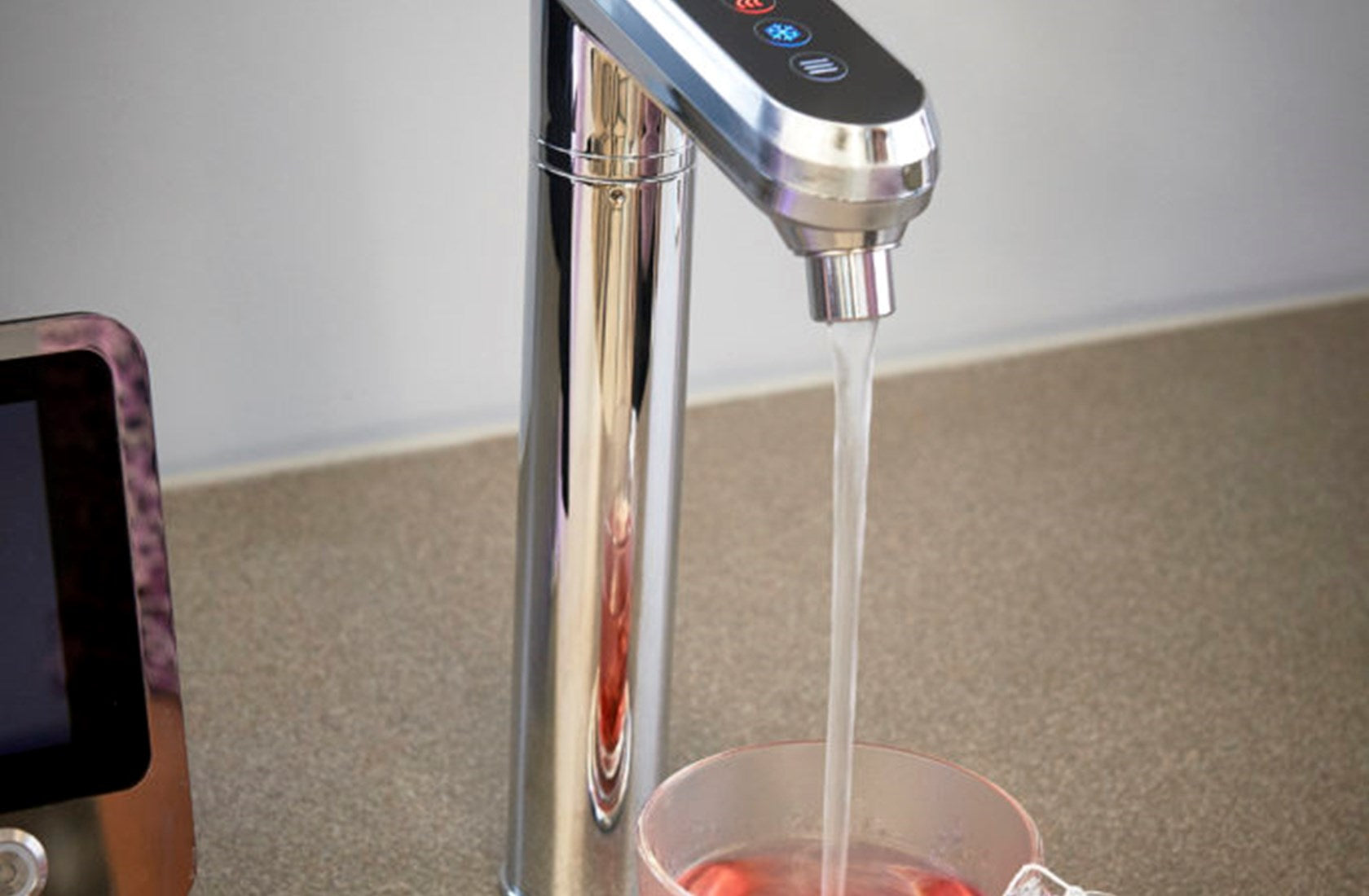
News
Why Limescale is Not a Problem with Aqua Libra Co Taps
on Sep 29 2025
Limescale certainly causes a lot of problems. It affects the operation and condition of machinery, the quality of water, and the aesthetics of appliances. The sheer number of limescale-removal products on the market today is testament to this common and troublesome side-effect of our water supply.
Interiors of washing machines, dishwashers, and pipes can get so badly clogged up with limescale that they cease to work effectively. Water flow is restricted, water pressure is reduced, and in the case of heat-exchanger systems, such as radiators and refrigerators, thermal conductivity is compromised. Limescale from the heating element of a kettle often breaks away to contaminate the boiled water, which is very unpleasant when it turns up at the bottom of your cup of tea or coffee.
Our homes and workplaces are populated with appliances and hardware that use, store, and deliver water. And where there’s water, there’s limescale.
… Unless you’re using a water-dispenser system from Aqua Libra Co.
What is limescale?
Limescale is an accumulation of mineral compounds, left behind on hard surfaces after water has evaporated or boiled. In many cases, these surfaces are the interiors of pipes and appliances, and limescale build-up goes undetected until some real damage has been done.
Around 68% of the UK’s water supply is sourced from rivers and reservoirs. The rest is extracted from aquifers, which are bodies of underground sedimentary rock that store water. In the UK, a large proportion of this rock is limestone, formed from compressed shell and bone of marine organisms that lived millions of years ago.
The rock’s capacity to hold water is its porosity.
Fracture porosity refers to the fractures and cracks in the rock, and intergranular porosity refers to the tiny spaces between the grains of stone. The porosity of the rock is calculated by dividing the total volume of the rock by the collective volume of the voids. For example, if the voids within a 60m3 volume of limestone total 3m3, the rock’s porosity is 1/20 (5%).
Limestone is made up largely of calcium carbonate (CaCO3). Magnesium and sulphur also make an appearance in our water supply, and so does iron, in various forms – most commonly iron monoxide (FeO), haematite (Fe2O3), and magnetite (Fe3O4). The presence of iron gives limescale a reddish-brown colour.
Calcium carbonate
An unusual characteristic of calcium carbonate is that it becomes more soluble in water as the temperature decreases. The hotter the water, the less soluble the calcium carbonate becomes. Which means, of course, that whereas some mineral deposits will be dissolved by very hot water, calcium carbonate will remain intact.
Carbon dioxide also has an effect on the solubility of CaCO3. When calcium carbonate reacts with carbon dioxide, calcium hydrogen carbonate (Ca(HCO3)2) is formed. More commonly known as calcium bicarbonate, Ca(HCO3)2 is much more soluble than calcium carbonate.
In the natural environment, dissolved carbon dioxide gas in rainwater reacts with calcium carbonate to form the more soluble compound, calcium hydrogen carbonate. Over millennia, this material dissolves, causing gradual but continuous reshaping of the landscape.
Descaling agents
Calcium carbonate is best treated with an acid; for example, hydrochloric acid, formic acid, acetic acid, or citric acid.
Hydrochloric acid (HCl(aq)) is a solution of hydrogen chloride and water, and it’s the main component of the gastric juice of mammals. The reaction between hydrochloric acid and calcium carbonate produces: water; carbon dioxide; and calcium chloride (CaCl2), which is a highly soluble salt.
Acetic acid (C2H4O2) is the main ingredient of vinegar, made by bacteria of the genus Acetobacter. With a plentiful supply of oxygen, the bacteria convert ethanol (C2H6O) to acetic acid and water:
C2H6O + O2 = C2H4O2 + H2O
Formic acid (CH2O2) occurs naturally in the trichomes (hairs) of stinging nettles. It’s also found in ants. Formic acid is named from the Latin word for ‘ant’ – formica.
Citric acid (C6H8O7) occurs naturally in some fruits (citrus fruits), for example, oranges, lemons, grapefruits, and limes.
All of these acids are effective limescale removers. In fact, washing windows with vinegar or squeezing lemon juice onto taps are traditional methods of dealing with limescale in the home.
What if there are no minerals in the water?
If there are no minerals at all in a water supply, there’s no limescale. No limescale means that water systems and machinery remain in better working order. And systems that are in good working order require less attention.
The Aqua Pure purification system eliminates all impurities from the water supply. This means that the drinking water you get from an Aqua Libra tap is totally free from waterborne bacteria and viruses and from all traces of minerals and plastic particles. It’s 100% pure water; H2O and nothing more.
How can you tell when water is pure?
When it doesn’t conduct electricity.
It’s the dissolved solids in water that conduct an electrical current – not the water molecules. So, if all impurities are removed from water, it won’t conduct electricity. This is how we test our water purifiers at Aqua Libra Co.
Why pure water?
Mineral water is not bad for your health. In fact, traces of calcium in drinking water can be beneficial for bones and teeth. However, there’s very little calcium in mains water, and the benefits are minimal.
The effect that limescale has on your appliances, though, is a lot more significant. Small amounts of calcium carbonate deposited on the insides of pipes and on heating elements soon mount up to a destructive coat of mineral armour that shortens the working life of your machines and contaminates your drinking water with scaly residue.
When machines start to slow down, callouts become more frequent. Service and maintenance costs rise. Energy consumption increases.
There's another reason for drinking purified water, and it’s at the very core of our mission to deliver the best hydration experience. Pure water tastes wonderful.
Contact us for information about Aqua Libra water-dispenser systems.
News
Why Are Plant-Based Diets Becoming So Popular?
on Sep 29 2025
All over the world, the popularity of veganism is growing. Few countries, however, are embracing the trend as enthusiastically as the UK.
In 2014, there were 150,000 (0.25% of the population) vegans in the UK. In 2019, there were 600,000 (1.21% of the population). In a period of five years, the number of vegans in the UK quadrupled, and almost a quarter of new products launched in the UK that year were labelled as vegan.
Consumer research in 2021 showed that 15% of Brits had completely cut out dairy products from their diets, and another 42% had reduced their dairy intake.
A 2022 survey of UK plant-based food trends revealed that 48% of adults in the UK are using plant-based milk alternatives, and 58% are using plant-based meat alternatives. Almost half of those who took part in the survey expressed an intent to reduce their intake of animal products.
There are four main philosophical reasons for adopting a plant-based diet:
Religion
Health
Animal rights
Sustainability
Religion
India has the lowest rate of meat consumption in the world. This tendency towards a plant-based diet is connected to ahimsa – the ideology of non-violence – which forms the basis of India’s main religions: Hinduism, Buddhism, and Jainism.
There are approximately 1.6 billion Hindus in the world, with about 1.1 billion living in India … May all beings look at me with a friendly eye, may I do likewise, and may we look at each other with the eyes of a friend. Yajurveda (a religious text)
India is home to around 8.4 million of the world’s 507 million Buddhists … All living things fear being beaten with clubs. All living things fear being put to death. Putting oneself in the place of the other, let no-one kill nor cause another to kill. Dhammapada (Buddhist scripture)
About 4.5 million people in India practise Jainism … There is no virtue of spirit greater than reverence for life. Mahavira (24th Tirthankara)
Followers of these three religions represent approximately 81.5% of India’s total population. Although Buddhism, Hinduism, and Jainism don’t preclude meat consumption, the philosophy of ahimsa does influence people’s choices. However, the influence is more towards vegetarianism than veganism.
Health (dietary veganism)
Animal-food diets are associated with higher cardiovascular morbidity. High intake of plant-based foods, on the other hand, reduces the risk of heart disease. Animal foods – meat, milk, eggs, and their derivatives – contain saturated fats. Eating a lot of these foods can lead to high cholesterol levels, which increase the risk of stroke and heart disease.
Animal foods contain very little fibre, whereas vegetables and grains are good sources of fibre. A fibre-rich diet helps keep cholesterol levels low.
Meat has been categorised by the World Health Organisation as carcinogenic. A plant-based diet reduces the risk of cancer.
Animal rights (abolitionist veganism)
Abolitionist veganism is a philosophy based on the right of all sentient beings not to be treated as property or resources. The word vegan was coined in 1944 by a leading campaigner for abolitionism, Donald Watson.
Abolitionist veganism objects to animal welfare movements that endorse humane treatment of sentient property, because the concept leads to public complacence and general acceptability of animal exploitation.
Abolitionist vegans also stand against using dietary health as an incentive for veganism, as this motive of self-interest obscures the point of abolitionism.
Sustainability (environmental veganism)
Animal farming contributes to global warming and threatens biodiversity.
Approximately 5 billion hectares (38%) of the world’s land surface is used for agriculture. Two thirds of this land is grazing pasture for livestock, and the rest is cropland. Roughly one third of the cropland is used to grow feed for livestock.
Forests are destroyed to make space for farmland. Reduced foliage means reduced CO2 absorption, causing atmospheric carbon dioxide levels to rise. Deforestation leads to reduced biodiversity – another threat to the world’s ecosystems.
Since the beginning of the Industrial Revolution, the concentration of atmospheric methane has more than doubled. Methane is a by-product of enteric fermentation, the organic decomposition by microorganisms (methanogens) in the digestive systems of ruminants. At present there are more than 264 million dairy cows worldwide, all emitting methane gas.
Reduced demand for animal-based foods will lead to reduced production.
Businesses all over the world are working together to bring about cultural and economic changes that will help us achieve net zero by 2050.
KOJO, in Devonshire Square, London, is one of those businesses. Specialising in 100% plant-based juices, shakes, and baked goods. KOJO’s sustainability agenda goes beyond veganism. The brand has joined City-to-Sea’s Refill Revolution and is working towards eliminating single-use plastics by offering free chilled and ambient drinking water to customers from two self-service Aqua Alto taps. Read more on our project with KOJO here.
Reduced demand for single-use plastic will lead to reduced production of plastic.
Contact Aqua Libra Co
If you’d like to talk to us about sustainable hydration solutions, give us a call on 0800 080 6696 or email [email protected].
You may also like to read about how to specify sustainable, innovative drinking-water systems.
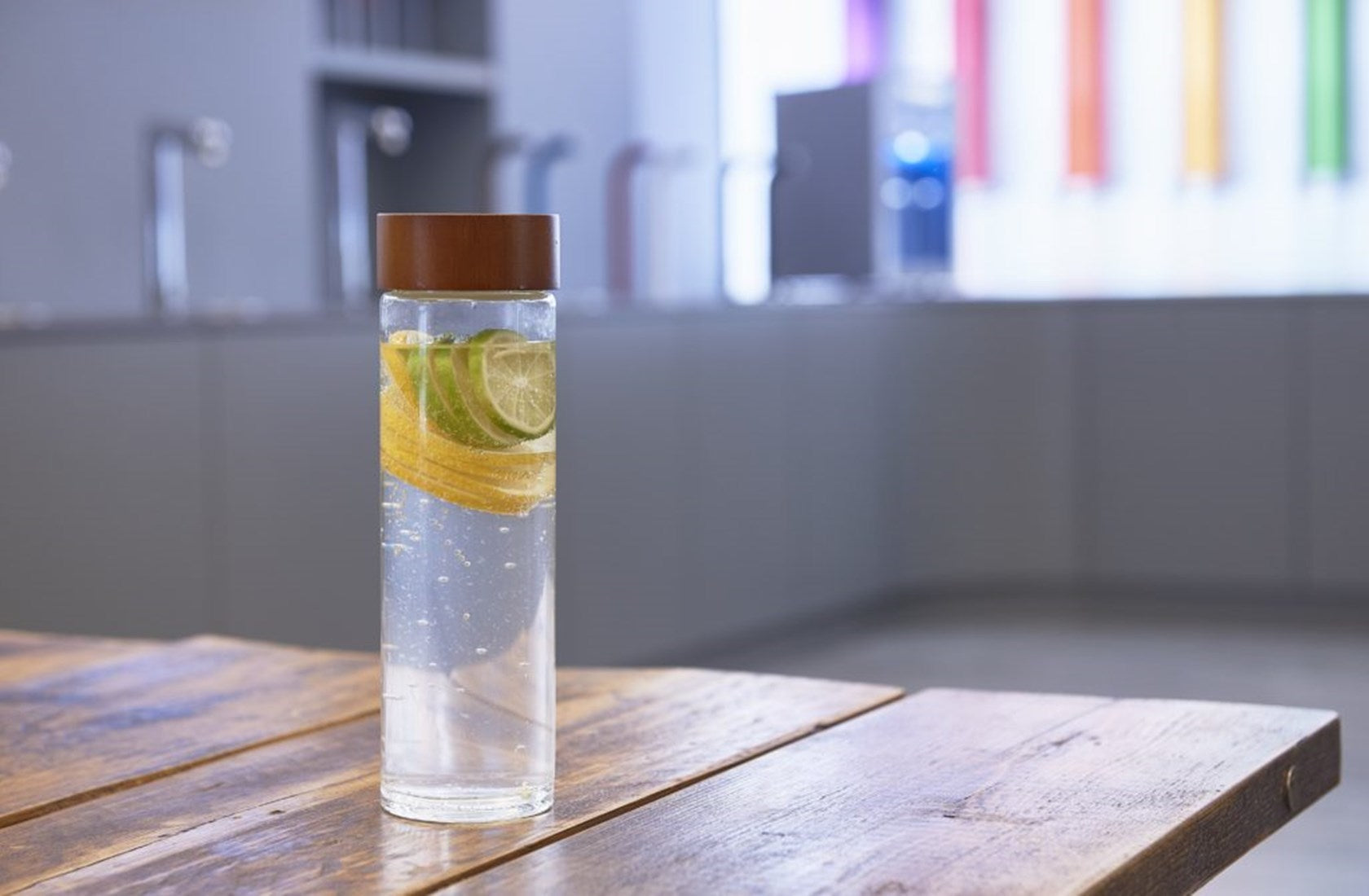
News
on Sep 29 2025
There are approximately 1.5 sextillion (1,500,000,000,000,000,000,000) litres of water on Earth.
Water plays a hugely important role in our lives. We use water for energy production, transportation, recreation, washing, and consumption. According to the International Covenant on Economic, Social, and Cultural Rights (ICESCR), access to drinking water is a basic human right.
Every living organism on Earth needs water to survive. This inorganic compound is vital for every function of the body, including digestion, absorption, circulation, temperature control, cognition, joint protection, and excretion. Water makes up between 50% and 75% of a human body – the water content being highest at birth and diminishing with age.
Let’s have a look at the link between hydration and wellbeing.
Blood circulation and the urinary system
Water makes up around 78% of our blood – approximately 95% of plasma, the liquid constituent of blood. Blood carries dissolved nutrients and oxygen to every cell in the body, and it takes away waste products, including carbon dioxide.
Having transported oxygen and nutrients to trillions of cells, blood is filtered by the kidneys, and the waste products are excreted through the urinary system. Minerals are dissolved in the urine (which comprises 91% to 96% water) and are flushed out of our bodies in the 1-2 litres of urine that we pass daily.
However, when blood is inadequately diluted, it reduces in volume and thickens. The heart then has to work harder to pump blood around the body. Palpitations and fatigue can be symptoms of dehydration.
Low dilution of urine means that minerals might not be thoroughly dissolved and flushed out, which can lead to crystallisation and urinary stones.
Higher volumes of urine also help to prevent infection. The more often we urinate and wash away bacteria, fungi, and viruses from our urinary system, the less chance there is of an infection developing.
Digestion and defecation
Water plays an important part in the metabolism (breaking down) of nutrients, in order that they can be absorbed into the blood; and it’s essential for the production of saliva and the digestion of soluble fibre.
Besides its role in the mechanics of digestion, water acts as a lubricant within the digestive tract, facilitating the process of moving matter through the intestines. The water content in stool helps to keep it soft and easy to pass.
The tissue of a healthy digestive tract is soft and pliable. If the tissue is dry, it will absorb the water it needs from the contents, leaving insufficient water for effective digestion and lubrication. Constipation and dry, hard stool are symptoms of dehydration.
Skeleton and joints
Synovia is a viscous fluid in cartilage that lubricates and cushions joints and spinal discs, reducing friction and absorbing shock. A deficiency of synovial fluid can accelerate the natural wear and tear of joints.
And what’s the chief component of synovial fluid? That’s right: water.
The brain
Water is vital in the creation of neurotransmitters – the power behind cognitive function. It’s also essential for the production of hormones, which regulate other bodily functions. An adult brain is around 75% water, but the brain has no storage solution for water; there must, then, be a constant supply of it.
As we’ve seen, water is vital for the conduit of oxygen to every cell in the body. The brain receives 20% of the oxygen supply. Thinking hard uses up more oxygen, so an efficient blood supply is an important factor in a well-functioning brain – a factor that also relies on good hydration.
Dehydration can negatively affect the production of neurotransmitters and hormones and reduce blood flow to the brain, causing confusion, lack of concentration, poor memory, inability to think logically, anxiety, stress, fatigue, and insomnia.
Between the meninges, surrounding the brain, cerebrospinal fluid acts as a shock absorber, protecting this most vulnerable organ from impact. When we’re dehydrated, the volume of cerebrospinal fluid reduces, causing headaches. Cerebrospinal fluid is 99% water.
Skin
One of the skin’s functions is temperature regulation. When we get too hot, our skin secretes fluid from the eccrine (sweat) glands. Through the process of evaporative cooling (transference of heat energy with the evaporation of the sweat), we cool down a little.
When we’re dehydrated, our skin loses moisture. If a dehydrated body becomes over-heated, it won’t perspire normally, which could be dangerous. Perspiration is also a method of excretion, and, just as with urination and defecation, a lack of water could mean that toxins aren’t being excreted.
Weight loss
When you drink cold water, you burn calories to bring the water up to body temperature. Any other cold drink, of course, will add more calories than it takes to warm the fluid. (For the same reason, adventurers in cold climates will heat snow before consuming it so as to preserve energy.)
Regular water intake will take the edge off your appetite, helping to reduce the amount you eat, as well as boosting your hydration levels. A few studies have concluded that drinking water speeds up metabolic rate, but there’s no real evidence to support this.
Pure water
The water we find in streams and rivers and wells and springs and taps is not pure water. It’s not simply H2O. Bottled spring water and tap water contain minerals such as magnesium, calcium, sodium, zinc, copper, fluoride, and potassium.
However, inorganic substances aren’t alone in drinking water.
Purification separates water from microscopic bacteria, algae, fungi, and minerals. Purified water is, purely, H2O and nothing else. Some people hold the opinion that the absence of minerals is detrimental to health; but the tiny amounts that occur in water can be more than made up for in the food we eat.
The big difference in purified water is the taste. Water has a variety of tastes, determined by the mineral content. Pure water, however, has no taste. The sheer delight in a glass of chilled, crystal-clear water is equal to the pleasure of the most delicious taste.
Hydration and wellbeing for the whole team
Access to pure, chilled water in the workplace promotes the health of the whole team. A high level of cognitive function and general well-being is conducive to productivity, innovation, and good attendance.
At Aqua Libra Co, we believe that water should be on tap in every single place of work!
